Kumbh Mela is more than a festival – it is a grand celebration of spirituality, faith and cultural harmony. In 2025, millions of devotees from across the world will gather in Prayagraj, Uttar Pradesh for the Maha Kumbh Mela, one of Hinduism’s most revered religious events. Held every 12 years, this sacred gathering has its origins in the ancient myth of Samudra Manthan, in which the ocean was churned by gods and demons in search of the elixir of immortality.
The Kumbh Mela, running from January 14 to February 26, 2025, offers pilgrims a chance to wash away their sins by taking a ritual bath at the Triveni Sangam, the confluence of the Ganges, Yamuna and the legendary Saraswati rivers. Unique celestial alignments during this period are believed to enhance the site’s spiritual energy, making it a particularly auspicious time for prayer, meditation, and self-purification.
Purna Kumbh vs Maha Kumbh
Purna Kumbh after 12 years, Ardha Kumbh every six years. This is Mahakumbh because it comes once 144 years i.e. after completion 12 Complete Aquarius And this is Mahakumbh itself Prayagraj,
Date of holy bath in Mahakumbh Mela 2025
Makar Sankranti (First Shahi Snan): 14 January 2025
Mauni Amavasya (Second Shahi Snan): 29 January 2025
Basant Panchami (Third Shahi Snan): 3 February 2025
Paush Purnima: 13 January 2025
Achala Saptami: 4 February 2025
Maghi Purnima: 12 February 2025
Maha Shivratri (Last Bath): 26 February 2025
These dates have immense significance, as lakhs of pilgrims will gather at the Sangam for these sacred baths which are believed to wash away sins and lead to spiritual purification.
Historical and mythological background
The Kumbh Mela has its roots in Hindu mythology, especially the story of Samudra Manthan or Samudra Manthan. Ancient texts describe this cosmic event as a joint effort between the Devas (deities) and Asuras (demons) to obtain Amrit, the elixir of immortality. During the churning a pot full of nectar emerged. To prevent the demons from claiming immortality, Vishnu, in Mohini form, took possession of the vessel and fled. On the way, a few drops of nectar fell at four places: Prayagraj, Haridwar, Ujjain and Nashik.
These four sites became sacred and started hosting the Kumbh Mela in turns. Prayagraj (formerly Allahabad) holds special significance not only because of its association with myths but also because of its geography. It is home to the Triveni Sangam, the confluence of the Ganges, Yamuna and the mythical Saraswati rivers, considered one of the most sacred sites in Hinduism, filled with extraordinary spiritual energy.
The Kumbh Mela follows a 12-year cycle based on the celestial positions of the Sun, Moon and Jupiter. Particularly notable is the 2025 Mahakumbh in Prayagraj, which occurs once every 144 years. It is believed that this rare astronomical alignment makes this festival a particularly auspicious period for spiritual practices. Pilgrims come to the rivers to take a holy bath to purify themselves of their sins and attain moksha (liberation).
Beyond its religious significance, the Kumbh Mela symbolizes an age-old cultural heritage, uniting millions of people in an extraordinary celebration of faith, devotion and communal harmony.
Importance of religious bath
At the core of the Kumbh Mela is the sacred ritual of bathing (sacred bath) in revered rivers. Pilgrims from all over the world gather at the Triveni Sangam – the meeting point of the Ganga, Yamuna and the mythical Saraswati – to take a dip in these spiritually charged waters. This ritual is not merely a physical act but is deeply symbolic, believed to provide immense spiritual benefits. In Hindu tradition, bathing during the auspicious days of the Kumbh Mela relieves sins accumulated over countless births, paving the way to moksha, or liberation from the cycle of birth and rebirth.
